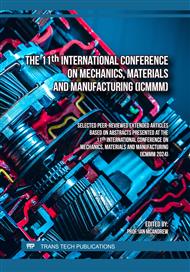[1]
N. E. Udoye, S.O. Uche-Abba, A.O. Inegbenebor, and O.O. Joseph, "The Behavioral Corrosion Characterization of Aluminium AA6061/Chitosan Composites," 2023.
DOI: 10.3233/atde230449
Google Scholar
[2]
S. Yahya, A.A. Rahim, A. M. Shah, and R. Adnan, "Inhibitive behaviour of corrosion of aluminium alloy in NaCl by mangrove tannin," Sains Malays, vol. 40, no. 9, p.953–957, 2011.
Google Scholar
[3]
K. Namitha, P. Rao, and S. A. Rao, "A brief insight into the use of plant products as green inhibitors for corrosion mitigation of aluminium and aluminium alloys," Canadian Metallurgical Quarterly. Taylor and Francis Ltd., 2022.
DOI: 10.1080/00084433.2022.2058155
Google Scholar
[4]
D. K. Sahoo, S. B. Chaudhary, N. Neupane, and B. H. Babu, "Improving the Mechanical and Corrosion Behaviour of Friction Surfaced Aluminium Deposition by Forced Convection NitrogenShielding Technique," Journal of The Institution of Engineers (India): Series D, 2023.
DOI: 10.1007/s40033-023-00496-5
Google Scholar
[5]
R. T. Loto, A. Ogunleye, O. Adeniyi, S. Ofordum, and A. Ale, "Comparative analysis of the corrosion resistance of Bos taurus and Cocos nucifera reinforced 1170 aluminium alloy in chloride-sulphate solution," 2023.
DOI: 10.21203/rs.3.rs-3219049/v1
Google Scholar
[6]
O. S. I. Fayomi and I. G. Akande, "Corrosion Mitigation of Aluminium in 3.65% NaCl Medium Using Hexamine," J Bio Tribocorros, vol. 5, no. 1, p.1–7, 2019.
DOI: 10.1007/s40735-018-0214-4
Google Scholar
[7]
J. I. Ahuir-Torres, H. R. Kotadia, T. T. Öpoz, and M. C. Sharp, "A Study on the Corrosion Behaviour of Laser Textured Pure Aluminium in Saltwater," Processes, vol. 11, no. 3, Mar. 2023.
DOI: 10.3390/pr11030721
Google Scholar
[8]
Z. Saeed Toor and M. Moaaz, "Corrosion degradation of aluminium alloys using a computational framework," Tribology and Materials, vol. 1, no. 4, p.150–156, 2022.
DOI: 10.46793/tribomat.2022.019
Google Scholar
[9]
I. P. Okokpujie, L. K. Tartibu, K. Babaremu, C. Akinfaye, A. T. Ogundipe, and E. T. Akinlabi, "Study of the corrosion, electrical, and mechanical properties of aluminium metal composite reinforced with coconut rice and eggshell for wind turbine blade development," Clean Eng Technol, vol. 13, Apr. 2023.
DOI: 10.1016/j.clet.2023.100627
Google Scholar
[10]
Z. Sun, Y. Ma, S. Ma, H. Xiong, and B. Chen, "Mechanical properties and corrosion resistance enhancement of 2024 aluminum alloy for drill pipe after heat treatment and Sr modification," Materials Today Communications, vol. 36. Elsevier Ltd, Aug. 01, 2023.
DOI: 10.1016/j.mtcomm.2023.106805
Google Scholar
[11]
D. Joslin Vijaya and D. S. Robinson Smart, "Experiments to find the corrosion and wear resistances and hardness of Al7075 metal matrix and NbC/Ti nanoparticles reinforcements composite," Mater Today Proc, May 2023.
DOI: 10.1016/j.matpr.2023.05.171
Google Scholar
[12]
I. Brahim, "Corrosion performance of aluminium alloys in chloride medium," no. November 2015, 2015.
Google Scholar
[13]
Z. Wang, X. Han, Z. Shao, K. Xiao, Y. Fan, and S. Wang, "Corrosion behavior of aluminum in a weak acetic acid solution containing halogen ions as simulated cooling water in HVDC transmission," Int J Electrochem Sci, vol. 18, no. 5, 2023.
DOI: 10.1016/j.ijoes.2023.100050
Google Scholar
[14]
K. Zhang and S. Yu, "Preparation of wear and corrosion resistant micro-arc oxidation coating on 7N01 aluminum alloy," Surf Coat Technol, vol. 388, Apr. 2020.
DOI: 10.1016/j.surfcoat.2020.125453
Google Scholar
[15]
X. Qi, Y. He, B. Jiang, and R. Song, "Effect of deformation and annealing on microstructure and corrosion behavior of 7075 aluminum alloy with micro arc oxidation coating," Surf Coat Technol, vol. 469, Sep. 2023.
DOI: 10.1016/j.surfcoat.2023.129791
Google Scholar
[16]
M. Kouřil, P. Novák, and M. Bojko, "Limitations of the linear polarization method to determine stainless steel corrosion rate in concrete environment," Cem Concr Compos, vol. 28, no. 3, p.220–225, Mar. 2006.
DOI: 10.1016/j.cemconcomp.2006.01.007
Google Scholar
[17]
G. Rocchini, "CORROSION RATE MONITORING BY THE LINEAR POLARIZATION METHOD," 1993.
Google Scholar
[18]
X. Han et al., "Corrosion resistance and microstructural characterization of Ti-Zr-V/waterborne resin composite conversion coating on 1060 aluminum alloy," Colloids Surf A Physicochem Eng Asp, vol. 678, Dec. 2023.
DOI: 10.1016/j.colsurfa.2023.132503
Google Scholar
[19]
O. S. I. Fayomi, I. G. Akande, A. P. I. Popoola, and H. Molifi, "Potentiodynamic polarization studies of Cefadroxil and Dicloxacillin drugs on the corrosion susceptibility of aluminium AA6063 in 0.5 M nitric acid," Journal of Materials Research and Technology, vol. 8, no. 3, p.3088–3096, May 2019.
DOI: 10.1016/j.jmrt.2018.12.028
Google Scholar
[20]
C.-J. Wang, P. Kusdiyarto, and Y.-H. Li, "Potentiodynamic polarization analysis with various corrosion inhibitors on A508/IN-182/IN-52M/308L/316L welds," Kuwait Journal of Science, vol. 51, no. 2, p.100202, Apr. 2024.
DOI: 10.1016/j.kjs.2024.100202
Google Scholar
[21]
C. Liu, Y. Liu, Z. Xia, Z. Wang, and B. Wu, "Coconut coir dust extract as a novel green corrosion inhibitor for carbon steel in the chloride-contaminated concrete pore solution," Journal of Building Engineering, vol. 82, Apr. 2024.
DOI: 10.1016/j.jobe.2023.108194
Google Scholar
[22]
B. N. Popov, "Basics of Corrosion Measurements," Corrosion Engineering, no. 865, p.181–237, 2015.
DOI: 10.1016/b978-0-444-62722-3.00005-7
Google Scholar
[23]
B. NaikD, V. RaoCH, S. RaoK, and M. ReddyG, "ScienceDirect Optimization of Friction Stir Welding Parameters to Improve Corrosion Resistance and Hardness of AA2219 Aluminum Alloy Welds," 2019. [Online]. Available: www.sciencedirect.com
DOI: 10.1016/j.matpr.2019.05.027
Google Scholar
[24]
S. Ananda Kumar, M. Alagar, and V. Mohan, "Assessment of corrosion-resistance of siliconised epoxy coatings by potentiodynamic polarisation method," Surface Coatings International Part B: Coatings International, vol. 84, no. 1, p.43–47, 2001.
DOI: 10.1007/bf02699695
Google Scholar



